The Armada Springs a Leak
After sealing up the exhaust in my recently-purchased 183K-mile 2008 Nissan Armada well enough to get it through the second-most stringent state inspection in the country, I dealt with noise from the serpentine belt. The problem turned out to be bad bearings on the timing chain tensioner, but there was also noise from the power steering pump, which led me to fix a leak from one of the PS hoses by replacing the constant-tension spring clamp with a worm-screw type clamp that could be tightened. That wound up slippery-sloping into fixing other under-engine leaks (the power steering uses automatic transmission fluid, so I needed to be certain the leaks were from the PS and not from the transmission), and that led me to a place I didn’t expect to go.
Fluid leaks should be looked at in terms of both substance and severity. That is, for lubricants, you can grossly triage them into drips, patches, puddles, and gushes. Drips are isolated “marking their territory” dots. Patches are fried-egg-sized stains on the garage floor. Puddles are things that have enough depth that you can swipe a finger through them and actually move fluid like Moses parting the red sea. Gushes are where you actually see fluid streaming out of the car and can follow it directly back to its source. Obviously you’d be foolish to drive a car that’s gushing any fluid further than down the driveway and into the garage, but the others are more of a judgement call. Anyone who owns a vintage car knows that it’s in their nature to leak engine oil, gear oil, and transmission fluid, and enforcing a zero-leak policy may not be possible. My Lotus Europa leaks fluid from the transaxle in quantities between a patch and a puddle, and I’ve replaced the transaxle seals twice in a misguided attempt to squelch it, only to learn in the forums that, basically, they all do that, and loving the car means living with its incontinence, placing a drip pan under it, and topping it up with a frequency usually reserved for engine oil.
But substance—which fluid is dripping—is critical. There should be a zero-leak policy with gasoline. Weeping a little gas isn’t acceptable. Any fuel leak should be found and fixed immediately, otherwise you risk your vehicle burning and you dying.
I regard coolant leaks as a big notch back from fuel leaks, but they’re still unacceptable. If coolant is leaking, even dripping, something is failing, and you can be certain that it’ll get worse over time. It won’t kill you, but it can kill your car by depleting the engine of coolant to the point where it overheats and warps or cracks the head. Driving a car that you know is leaking any amount of coolant any more than around town isn’t dangerous, but it’s dumb. Don’t do it. In my BMW-centric world, where I road-trip 50-year-old cars thousands of miles and daily-drive 20-year-old cars with plastic-laten cooling systems that crack at any moment and dump the coolant, I’m hyper-vigilant about cooling leaks. The cause could be a loose hose clamp, or corrosion on a metal coolant neck not allowing a hose to seal, or a bad water pump seal, or an actual hole in the radiator or heater core, or, in a modern car, failure of a plastic component. Visual inspection with the engine running usually reveals the source. Pressure testers that screw in in place of the radiator cap can also be helpful if the leak only occurs at operating temperature.
So, back to the Armada. There were two other places where the rubber PS hoses were leaking where they’re pushed over metal lines and secured with spring clamps. The worst of them was where two lines ran through the engine compartment on top of the left frame leg. It was the lower one that was leaking, and the upper one blocked the access to getting vise grips on the spring clamp. I wound up having to remove the inner fender liner in order to get at it from the side. As with the first PS leak, installing tighten-able worm clamps stanched the leak.
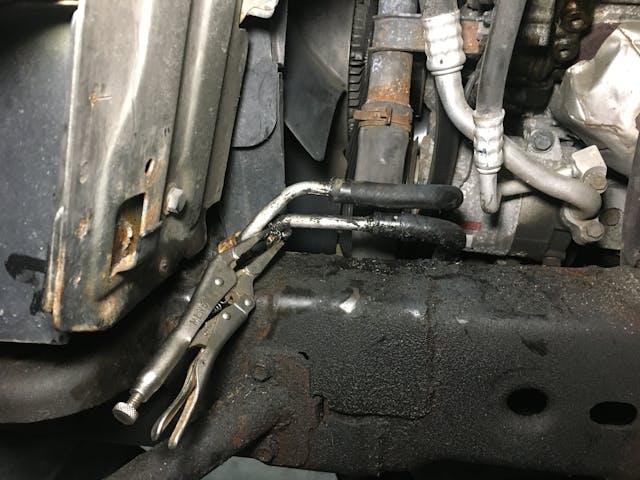
The remaining PS leak took me a while to find. A drip kept forming below the steering rack on the frame. To find the source, I had to lie under the car with the engine running and watch. Unfortunately, it’s coming from where the input shaft goes into the top of the steering rack, and replacement of the seal likely requires removal of the rack, which in turn requires removal of the front differential. Further, the seal is in the middle of—get this—a seven-sided nut for which I’ve yet to locate any reference to a removal tool. Fortunately, it’s a small leak, so for now I’m going to let it go.
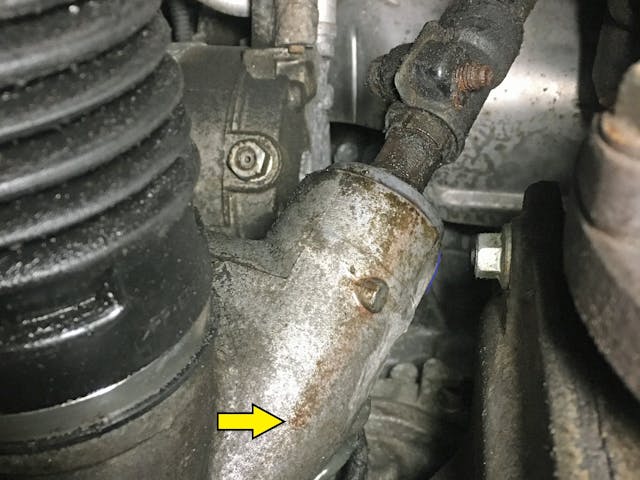

But while I was under the Armada’s nose, I found, to my surprise, drops of coolant at the bottom of the radiator and stray ones higher up. When I bought it, I knew about the wetness that was likely from the power steering, but the coolant leak was not something I was aware of.
It turned out to be leaking from two places. The first was from below the radiator cap, where a thin hose attaches that feeds the overflow tank. Like the PS hoses, it was leaking from the spring clamp, so I replaced it with a worm clamp, but it continued to leak from the brass fitting to which the hose was attached. At first, I didn’t understand what I was seeing—the fitting seemed like it swiveled. Then I realized that there had originally been a little plastic coolant neck there, it had snapped off (a very common problem on plastic radiators), someone had jury-rigged it with a screwed-in brass fitting and sealed it with Teflon tape, and it was now loose and leaking.
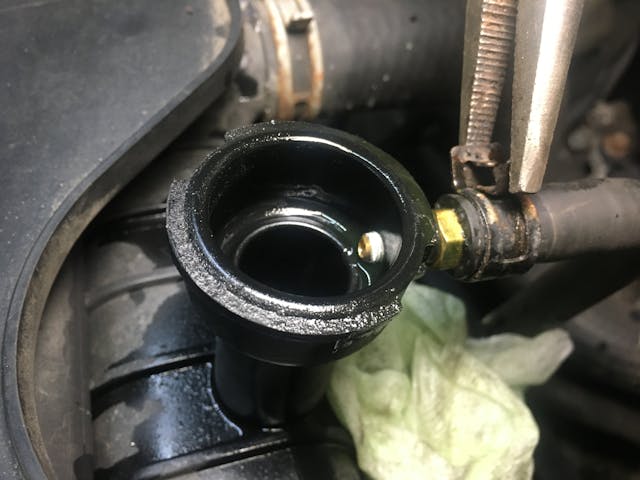
I first tried Permatex Thread Locker. That leaked, so I went to Gorilla Glue. That leaked too, so I was prepared to go nuclear with J-B Weld when I discovered a second leak.
This one was from someplace more serious—where one of the automatic transmission lines went into the plastic tank at the bottom (the radiator also acts as a transmission cooler, as it does on many vehicles). It wasn’t leaking from the hose, so replacing the spring clamp as I’d done elsewhere wouldn’t matter. It looked like the leak might be coming from a seal behind the fitting that ran through the plastic tank, but my attempt to loosen or tighten the nut only caused the plastic to flex and the leak to increase.
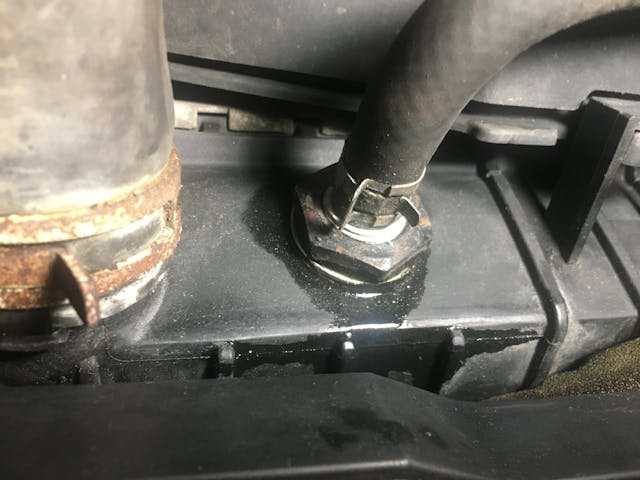
In addition, one of the things I read about the Armada is that the radiator’s internal transmission-cooling plumbing eventually cracks, allowing ATF and coolant to intermix. This creates the dreaded “strawberry milkshake” that causes the transmission to fail. I checked the date code on the radiator, and it was original to the car. Taking these three things together, I would’ve been an idiot to not replace the radiator, and as I often say, I try not to be an idiot. Seriously—it’s one thing for something to break with no warning, and quite another to be stranded and sit there thinking, “Yeah, I should’ve replaced that.”
As with everything I do, I looked at the cost. Folks who routinely tow big trailers install a separate heavy-duty transmission cooler. Others replace the radiator, either with the original Nissan part, or a less-expensive aftermarket choice, or an aluminum one. RockAuto has several cheap radiators, but these things are big, and with shipping they came to about $150. The correct Nissan radiator with its known shortcomings could be had on eBay for as low as $180. These days the world is full of decently-priced Chinese-made aluminum radiators. I’ve used them in a variety of cars. The weld quality varies from decent to cringe-worthy, but I’ve never had one leak. Whether or not to use one is a question of fit and vibe. I think they look completely out of place in my beloved BMW 2002s, and besides, they’re too thick to use without deleting the original cooling fan, which I refuse to do, but I have one in my Lotus Europa and use them in some of the later BMWs. The Armada forum said that there’s plenty of room for a three-row or even a four-row aluminum radiator, but fit-wise, the fan shroud needs to be fettled with.
I would’ve preferred to buy an aluminum radiator on Amazon so that I could return it cost-free if it wouldn’t fit, but the cost there was $250 for the same radiator that was $185 on eBay. Then I found a new eBay vendor with zero feedback selling the same radiator for $165 (drop-shipped from the same port in Perth Amboy, New Jersey, as nearly every other seller). There was the risk that the vendor wasn’t real, or the radiator was damaged or open-box, but I clicked and bought, and I was relieved when an intact new radiator arrived two days later in a sealed box.
As the box sat in my kitchen, I thought, “Damn, this thing is big.”
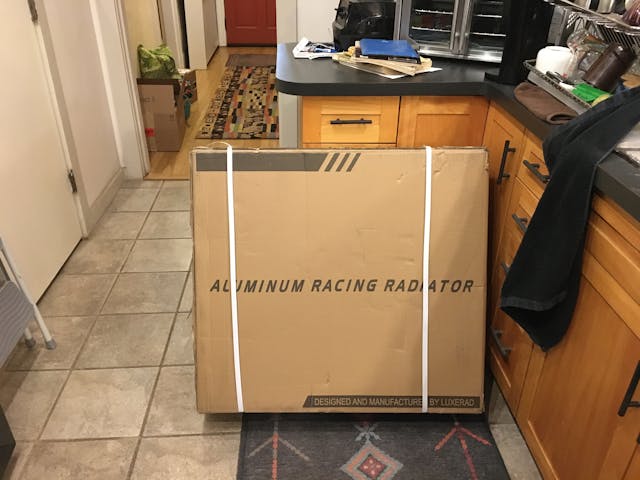
Replacing a radiator on a vintage car consists of draining it, removing the upper and lower hoses, removing the four bolts holding it to the nose, and done in 15 minutes, tops. But on newer cars, it’s typically far more complicated. On the modern BMWs that I’m familiar with, it’s like one of those interlocking rope-and-ring Chinese puzzles, where an odd dance needs to be done with the fan, the shroud, and the expansion tank. On the Armada, the fan and shroud were straightforward, but it turns out that the power steering fluid cooler and the A/C condenser are attached to the front of the radiator, so the dance involves unbolting the condenser, then tilting the radiator forward so you can unbolt the PS cooler.
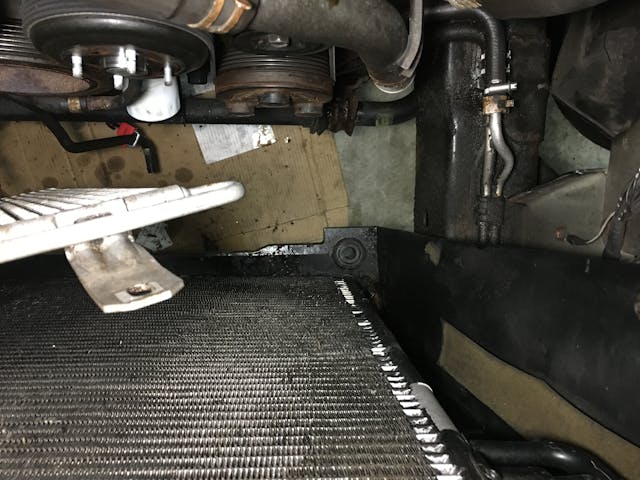
Despite its size, I expected the original plastic-tanked radiator to be fairly light, but a combination of fluid remaining in it and it sticking to its rubber mounts made it a “don’t do that” to my 65-year-old back, so I elicited help from one of my kids to muscle it up and out. I test-fit the shroud on the new radiator and did some cutting to get it to seat around its upper tank.
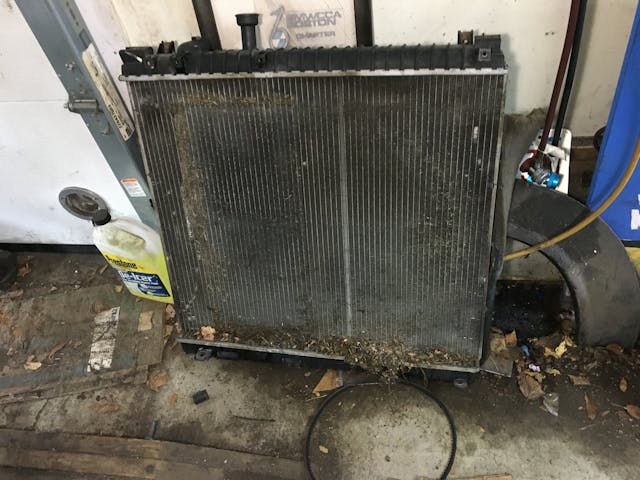
When you replace a radiator, there’s the question of how much of the rest of the cooling system you should prophylactically replace, even if there’s nothing wrong with it. If the water pump or the thermostat or the fan clutch go south on me, I’m certainly going to be pissed that I didn’t just replace them while they were all accessible, but the fan clutch feels fine, there’s no play or leakage in the water pump pulley, and the car warms up perfectly. I did, however, inspect the hoses at the front of the engine and found that the aluminum neck to which the upper radiator hose is attached was badly corroded. I replaced the hose and cleaned the neck. The lower radiator hose looked OK, but for symmetry I replaced it at the same time.
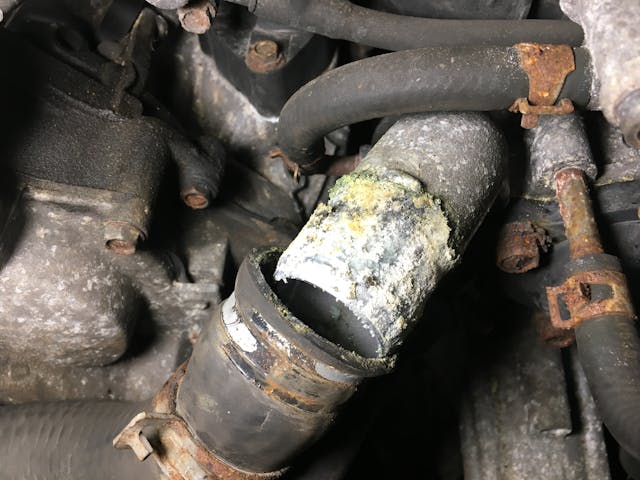
Dropping the new radiator in wasn’t nearly as bad as removing the old one, as I had gravity on my side, but getting the cooler and condenser reattached was challenging. I dropped the condenser attachment bolts down into the nose multiple times and had to fish them out with a magnetic wand.

When the radiator, shroud, and fan were all installed, I spun the fan by hand and heard it hitting the shroud due to lack of clearance on the left side. I could’ve pulled it back out and trimmed that side, but the only bolt-on attachments are at the top, so even if I created clearance, there was nothing to hold it in place. So in true Hack Mechanic fashion, I installed a very stout zip tie at the bottom corner that pulled it where it needed to be.
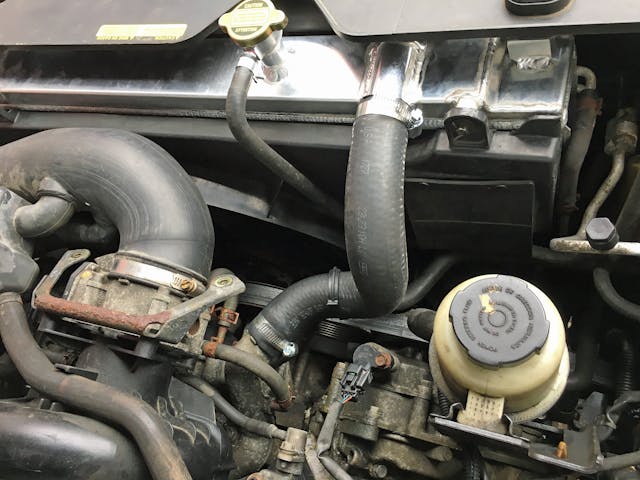
I did the drive-park-check cycle a few times to be absolutely certain no coolant was leaking and the only remaining leak was the trickle from the steering rack’s input shaft, then deemed it roadworthy.
So in terms of the Armada’s punch list, that leaves the front struts. I’ll get to that next week.
***
Rob’s latest book, The Best Of The Hack Mechanic™: 35 years of hacks, kluges, and assorted automotive mayhem is available on Amazon here. His other seven books are available here on Amazon, or you can order personally-inscribed copies from Rob’s website, www.robsiegel.com.
Check out the Hagerty Media homepage so you don’t miss a single story, or better yet, bookmark it. To get our best stories delivered right to your inbox, subscribe to our newsletters.



Ah, zip-tie to fix the shroud clearance issue – I LOVE it – you have restored our faith in your title, Hack!
RE: dropping bolts and retrieving with magnetic wand – don’t we all wish that we could have on/off magnetic fingertips so we could hold a bolt, washer, or nut securely in a tight spot while getting it in place and started? We can get new hips, new hearts, new boobs, darned new everything. Why hasn’t science developed what we gearhead DIYers really need?
It seems as if the Armada is getting closer to being what you bought it to be!
Try using a small magnet in the fingertip of a latex glove, it works most of the time for me!
At first I guffawed, but that’s actually a pretty good idea and I’m definitely going to try it!
That is brilliant!
And you can use the extras from your Chinese Freight LED shop lights that are never permanently attached!
Google finge glover and you can find a magnetic sleeve that fits over your fingertip or gloves with a magnetic finger. Very clever. They can make threading a bolt in a tight spot easier or is another good way to retrieve lost magnetic parts.
Zip ties are one of the best inventions ever made. First time I’ve seen them employed to tweak shroud clearance!
This is timely as I’m about to replace the radiator in my 94 Miata. This after replacing the radiators in both my wife’s Nissan and my Honda. All plastic tank radiators eventually leak at the seams. In the case of the Miata, I wanted to replace old coolant hoses and bought a complete proper set of Mazda hoses, which cost more than the radiator. Just a generic plastic tank radiator with aluminum core from Rock Auto, less than $100, but with hoses and proper coolant the total is closer to $300. Replacing the radiator (which is not original but is now at least 25 years old) is simply prudent, and you might as well if you’re dumping the coolant.
Clearly the former owner of your Armada was using economical sea water as a coolant… I’d be installing a new water pump, thermostat and housing and the best coolant money can buy right after I ran whatever miracle flush product I could find through the engine to try and clear out the arterial sclerosis you can’t see. Yikes.
Not sure if it is kosher to mention a product, but I used Evapo Rust’s Thermocure to flush out the cooling system of my 95 Caprice wagon with the LT1. I mention the LT1 as it has the “steam” lines for the heads. Initially the “water” coming out of the engine looked like chocolate milk. I put the Thermocure in and followed the instructions, “run it for a few hours up to several days”. I went 6 days. I then took each “water circuit” and flushed and back flushed each circuit to until the water was clear going both ways. Amazingly enough all circuits ran clear!!! Heater worked better too. Put in a new radiator and coolant tank as they were toast. They actually looked like they were filled with toast. Refilled with coolant, water wetter and distilled water. Been over two years now and it still runs clear. Hmmm, two years, maybe it’s time for a flush.
Here’s an outfit that sells lug nuts with seven sides. They also sell the socket to fit them. Of course, it’s too much to ask that the socket fits your seven-sided nut, but it might be worth a shot. https://bloxracing.com/products/7-sided-forged-ti-extended-lug-nut-set
Zip ties are the best and worst thing around. At times they can do a lot of good but too often they get used on things like radiators and not tight enough to prevent a leat in the future.
Also I have a number of customers using universal racing radiators for street application. About 2/3 get it right and 1/3 call back to get the right Radiator as the universal is just not going to work.
I too had a power steering shaft seal leak. Each time the level dropped I refilled it with power steering stop leak. Leak eventually stopped. Five years later still working fine with no leaks.
Sir, your trials with your Nissen (and BMW) have convinced me to NEVER buy a car with plastic-anything-that-contacts-liquid. And sheet metal constant-loose hose clamps get s-canned on sight, leaking or not on any car I own or work on. Good luck next week with your struts.Be prepared for the top strut nut to bee frozen. They can be cut, though.
Just replaced the original radiator for my 63 corvette. Didn’t leak but wasn’t cooling very well. $1,200, on sale so I’m not feeling a whole lot of sympathy toward your radiator expenditure.
In recent years I replaced one radiator with an aluminum radiator (because the original is not available) and one with the plastic tanks. I see pros and cons. My biggest concern with the all aluminum unit is it will spring pinhole leaks… hasn’t yet. One thing I’ve learned about the plastic tank radiators is they can leak from the seams intermittently and pass a pressure test in between. I chased down an intermittent coolant leak for over a month where I would lose half a gallon in a drive. I finally caught it once… the seam opened up, puked out coolant, then closed up again… after passing several pressure tests
Pick your poison
Yes, radiator sandwiches. Will that be mustard and a pickle on the side sir …
fitting a diesel 94 cummings engine into an 89 dodge pick up truck and keeping it stock looking
Using an aluminum racing rad we shoe horned …it all in ….leaks are not an option
but air flow was
The sandwich was Transmission cooler. Air conditioning /full intercooler / 4 row radiator.
The transmission cooler got pulled a year later on when I put in the five speed from a GM 4500
Some designer really doesn’t want you messing with that rack nut. A stilson wrench would take it off though the rack would have to be out of the car to get the swinging room. I wonder if tightening it would help, like a valve packing.
I always like to see a more solid item (theoretically more solid) such as an aluminum rad replacing a mainly plastic one. There is something satisfying about that. The power steering rack issue sounds a bit vexing. Seven-sided packing nuts?!?! Goodness.
Save yourself some time and effort by adding some “Trans-X” to your power steering fluid. I would bet your leak will stop. Trans-X has been around for decades and it works like magic.
Not surprised the radiator was needed given what else was going on. The brass fitting hack was a surprise to find I’m sure.
Enjoyed the article. Loved the poster for Forbidden Planet!
One of my kids was set designer in a high school production of Grease. One of the sets involved these big reproductions of movie posters that the kids themselves had painted. When the show was over, I asked him what was going to become of the paintings. “They’ll be trashed,” he said. I asked “Can I have the Forbidden Planet one?” It’s HUGE. I had to borrow a pickup truck and suspend it over the bed. It’s been in the garage for 15 years, with Robbie the Robot towering over everything else.
That’s cool!